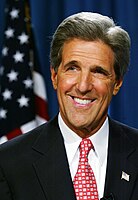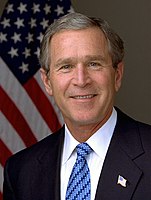
Back Élection présidentielle américaine de 2004 en Pennsylvanie French Pemilihan umum Presiden Amerika Serikat di Pennsylvania 2004 ID
| ||||||||||||||||||||||||||
| Turnout | 68.9%[1] | |||||||||||||||||||||||||
|---|---|---|---|---|---|---|---|---|---|---|---|---|---|---|---|---|---|---|---|---|---|---|---|---|---|---|
| ||||||||||||||||||||||||||
| ||||||||||||||||||||||||||
| ||||||||||||||||||||||||||
| Elections in Pennsylvania |
|---|
 |
|
|
The 2004 United States presidential election in Pennsylvania took place on November 2, 2004, and was part of the 2004 United States presidential election. Voters chose 21 representatives, or electors to the Electoral College, who voted for president and vice president.
Pennsylvania was won by Democratic nominee John Kerry by a 2.50% margin of victory. Although no Republican carried this state in a presidential election since Bush's father George H. W. Bush in 1988, early polling showed the race was a toss-up, thus was considered as a possible target for the Republicans. Prior to the election, most news organizations considered this a toss-up, or a crucial swing state. Later polling favored Kerry, leading half of the news organizations to predict that Kerry would win the state, but the other half still considered it a swing state. Although the Commonwealth of Pennsylvania voted for the Democratic presidential nominee in six subsequent elections since 1992, the margins of victory had become smaller over the past elections. On election day, Kerry won the state with 50.92% of the vote, but won only 13 of the 67 counties in Pennsylvania. Most of these 13 counties have the highest populations in the commonwealth. The biggest key to Kerry's victory was winning Philadelphia County with 80.44% of the vote.
Bush was the first president elected to two terms in office without carrying Pennsylvania either time since Woodrow Wilson in 1912 and 1916, and is to date the only Republican presidential candidate to win the presidency without carrying the state at least once, as well as the most recent Republican to win without the state. Although Pennsylvania was also not carried by the winner of the 2000 presidential race, this election also marked the first time since 1968 that Pennsylvania voted against the winner of the national popular vote. Bush was the first Republican to win the national popular vote without Pennsylvania since the 1968 presidential race.
As of 2024, this is the most recent election to date in which Pennsylvania would vote for the losing candidate, thus the state is tied with Wisconsin and Michigan for the longest bellwether streak in the nation.
- ^ "As far as voter turnout, 2012's got nothing on 2008". WHYY. Retrieved September 5, 2024.



